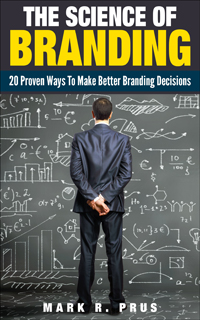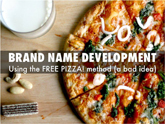Mark
Taco Tuesday & The Trademark Bully

Photo by ABDALLA M on Unsplash
The United States Patent and Trademark Office (USPTO) defines trademark bullying as “the act where the trademark owner uses its trademark rights to harass and intimidate another business beyond what the law might be reasonably interpreted to allow.”
The classic example of a trademark bully is Apple. Here is an example of their overreach. As detailed in this article, Apple is challenging farmers in Switzerland over their use of an apple in their logo as shown below. I don’t know about you, but this use of the apple image doesn’t seem like it is infringing on the Apple Inc. use of an apple.

This is not the first time Apple has pursued action against another company’s apple trademark. The most famous example is when Apple Inc. challenged Apple Corps (the record company owned by The Beatles). In 2007, Apple Inc. and Apple Corps reached a settlement of their trademark dispute under which Apple Inc. owns all the trademarks related to “Apple” and will license certain of those trademarks back to Apple Corps for their continued use.
I do understand the need to challenge other companies when a trademark application comes close to home. The law demands that a trademark owner defend its trademark against such incursions or else it can lose its trademark protection. However, I can also attest to the fact that these defensive actions are often perceived as “big company beating up the little guy” and can generate lots of negative PR.
The Taco Tuesday trademark fiasco is a different approach by a big company. “Taco Tuesday” has been trademarked for more than 40 years by Taco John’s, a fast-food chain from Wyoming. However, in May, Taco Bell filed a challenge with the U.S. Patent and Trademark Office, urging the agency to cancel the “Taco Tuesday” trademark so it would be “freely available to all who make, sell, eat and celebrate tacos.”
Let me repeat that. Taco Bell decided that a valuable trademark that is owned by a competitor should be invalidated, and started legal proceedings to challenge the trademark.
This is just another form of trademark bullying (or is it Trademark Blackmail?). In this case, Taco Bell, a large global company with deep pockets, has thrown down the gauntlet against a much smaller company, Taco John’s. Their actions indicated that they were coming after Taco John’s trademark and would be willing to sue to get it. I won’t try to predict who would win a lawsuit, but I tell you with certainty that Taco Bell would have a lot more funding and lawyers to persist in the lawsuit and appeals than Taco John’s would. Taco John’s CEO Jim Creel said in a statement that paying millions to defend the trademark didn’t “feel like the right thing to do.” “As we’ve said before, we’re lovers, not fighters, at Taco John’s,” Creel said.
Taco John’s gave up a valuable trademark rather than fight an expensive legal battle. They did so in noble fashion, by issuing a challenge to Taco Bell and other competitors. Instead of spending money on the trademark dispute, Taco John’s donated around $40,000 to the nonprofit Children of Restaurant Employees, which provides financial aid to restaurant workers when they, a spouse or their children face a life-altering crisis. “Let’s see if our friends at Taco Bell are willing to ‘liberate’ themselves from their army of lawyers by giving back to restaurant families instead,” Creel said.
But still…another big company gets away with “legal” bullying…again.
How to Name Your Startup in 8 Simple Steps
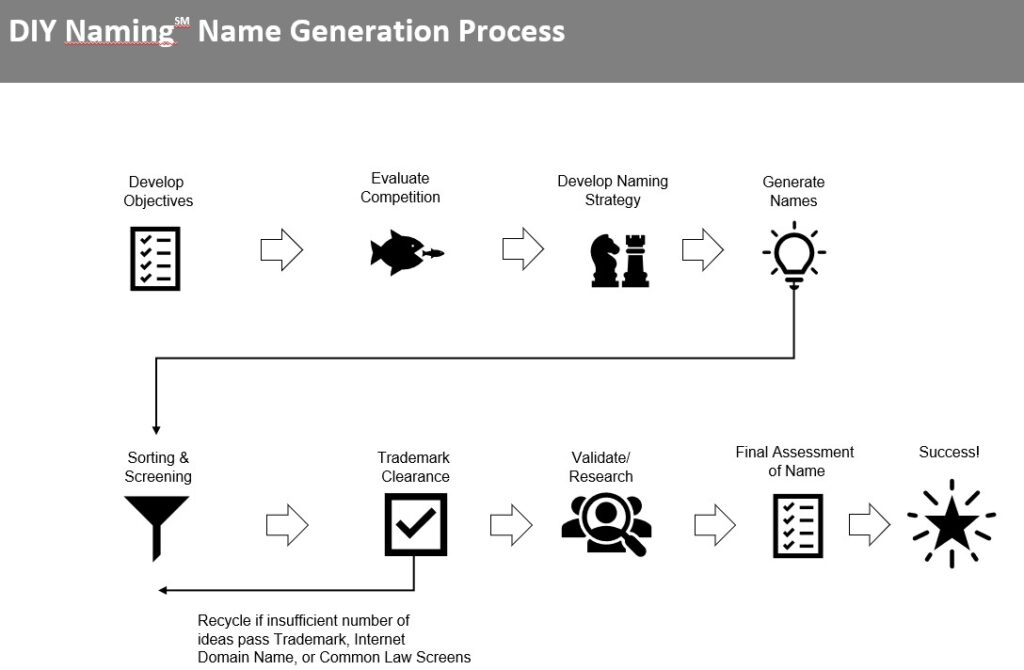
This article provides a process you can use to name your business, product, or service. There are 8 simple steps and if you do the work that is required, you can develop a great name very quickly.
FULL DISCLOSURE: I am a professional name developer with 25+ years of experience in branding and marketing. Companies pay me a significant amount of money to develop names for them. I also wrote a book titled DIY Naming (https://payhip.com/b/lzPH8) that expands on the process in this article. But you don’t have to hire me or buy my book if you would rather “Do-It-Yourself!” So let’s get started!
Step 1: Develop Objectives
Most people who start a business have a single-minded objective for naming => Develop A Great Name. But what does that mean? The reason you develop naming objectives before you start to brainstorm is to decide what you want the name to do for you and to provide criteria for evaluating names.
When developing the objectives for your naming project, you should consider the following questions:
- What does the future look like and what role will your company play in it?
- What is the current and future competitive set and how do you want to differentiate from the competition?
- How do you want your customer to feel after hearing/reading your name?
- What are the unique attributes of your company/product/service and how do you want your name to reflect that uniqueness?
- How will your business expand in the future and how can your name flex to fit that future?
- Can your name project a certain image or personality?
- How will I know when I have identified a great name?
One tool I use to evaluate names is The Name Evaluation Tool, a simple 10-Step Checklist to evaluate a name. It will quickly give you an idea of the strengths or weaknesses of your names. It will also tell you where your names are lacking, so you can go back to the drawing board. I have found this tool to be very helpful in setting up objectives for a naming project.
Your naming objectives might be as simple as: “We have a groundbreaking product that will revolutionize the ABC industry, so we want a name that stands apart from the competition and evokes the future that we imagine. The name must be easy to pronounce, read and spell, and be memorable. Most importantly, the name must convey the benefits that our product delivers and must give our target customers the belief that we are the new market leader.”
But wait! Don’t write down your objectives in ink just yet. Do the next step to help you understand how to stand out versus the competition.
Step 2: Evaluate Competition
Here is a visual way to demonstrate why the competitive set is so important to consider. In the three groups of circles shown below, the circle in the center is always the same size. However, as you can see, the center circle looks smaller or larger based upon the size of the other circles surrounding it. The group of circles on the right has six similarly sized circles, and you can see how it is impossible to distinguish one from another. It is far better to be the outlier, such as the center circle in the first two groups of circles.
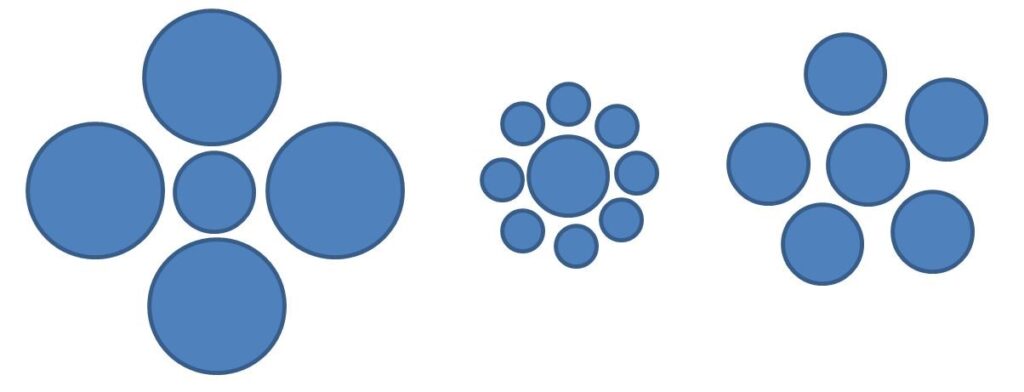
Don’t be like the group of circles on the right. Make sure you develop a name that ensures you will stand out versus the competition!
One way to do that is to consider the type of name you wish to develop. Start by listing all the companies that you consider to be competitors. You should have a list of at least 8–10 companies. And please don’t say “I have no competition.” Everyone has competition. If you think about your company’s product or service and think of possible substitutions for them (even if you consider them to be inferior), then you will easily generate names of competitors. If you are in doubt, visit Amazon or Google and enter your product into the search bar. You will find your competitors.
The next step is to assess the names of the competitors and place them into the spectrum as shown below.
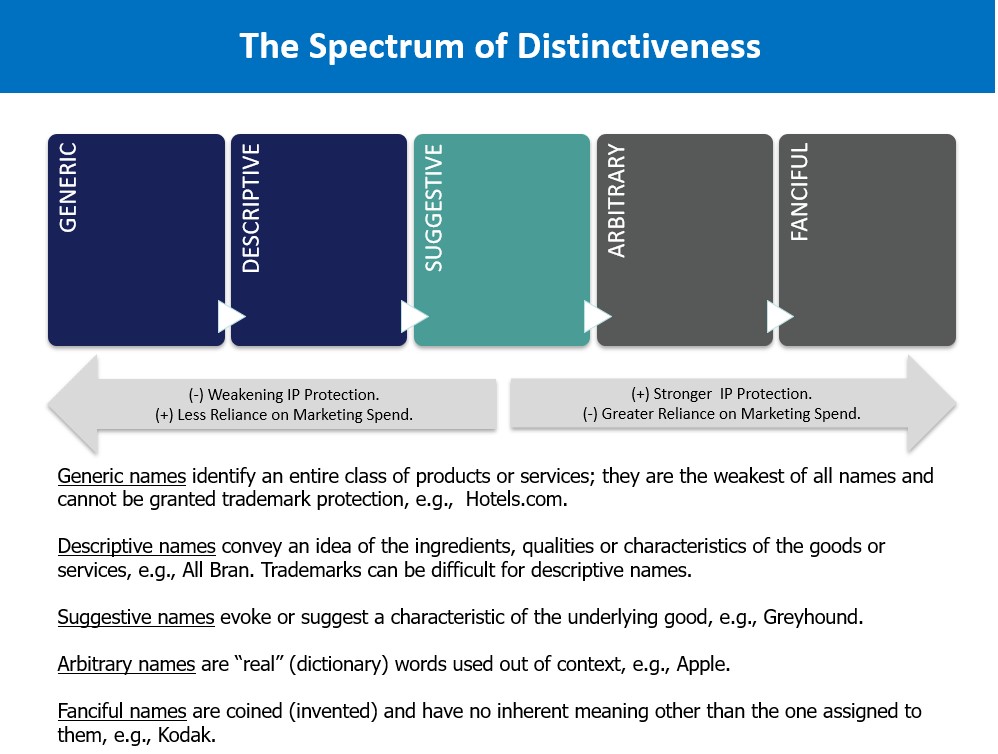
Once you understand where your competitors are, you can formulate your own strategy for standing out. For example, if the competitive set for your food chopping device consists of products with descriptive names like EZ Chop, Speed Chop, QuickChop, or TurboChop, don’t call your product FastChop because you will get lost in the field of sameness at the shelf. In this case, you should avoid descriptive names altogether.
In the example I provided earlier, you might want to modify the objective to mandate development of a fanciful name as those are often considered to be cutting edge or high tech. The revised Naming Objectives might be: “We have a groundbreaking product that will revolutionize the ABC industry, so we want a fanciful or invented name that stands apart from the competition and evokes the future that we imagine. The name must be easy to pronounce, read and spell, and be memorable. Most importantly, the name must convey the benefits that our product delivers and must give our target customers the belief that we are the new market leader.”
Step 3: Naming Strategy
Never start a name development project without a solid strategy. You need to have a strategic positioning that provides a solid foundation for your branding and marketing efforts. The entire marketing strategy can be summarized in one statement that is called a Brand Positioning Statement.
There are five components to a positioning statement:
- Target Audience — A demographic and attitudinal description of the core prospect to whom the brand is intended to appeal.
- Frame of Reference — The category in which the brand competes.
- Point of Difference — The most compelling and motivating benefit that the brand can own in the hearts and minds of its target audience relative to the competition.
- Reason to Believe — The most convincing proof that the brand delivers what it promises.
- Personality — The tonality of your brand expression.
Positioning Statement Format:
For (target audience), (brand name) is the (frame of reference) that delivers (point of difference) because only (brand name) is (reason to believe). We will express this positioning as (personality).
Once you nail this positioning statement, you will fully set the guidelines for development of your name.
Step 4: Generate Names
Now for the fun part!
You probably already have a list of names, so now you are looking at how to expand the list. I suggest you do that by starting with keywords. Begin by compiling a very comprehensive list of keywords for your company, product, or service. Keywords include:
- Search Terms — What do people use when they search for you?
- User Terminology — What do people say when they talk about you?
- Common Reference Terms — Category reference terms.
- Product Benefits — What does your product offer?
- Synonyms — Identify words that mean the same as another keyword.
- Desirable Attributes — What do you want to be to your target?
This list gets used with several of the later steps, so continue adding words until you feel completely stuck. Shoot for 50+ keywords on your list.
Once you have a broad and deep list of keywords, you can begin creating names from these keywords. For example, if you have a list of product benefits as keywords, you might try to convert one of them to a name as we did when naming this product:
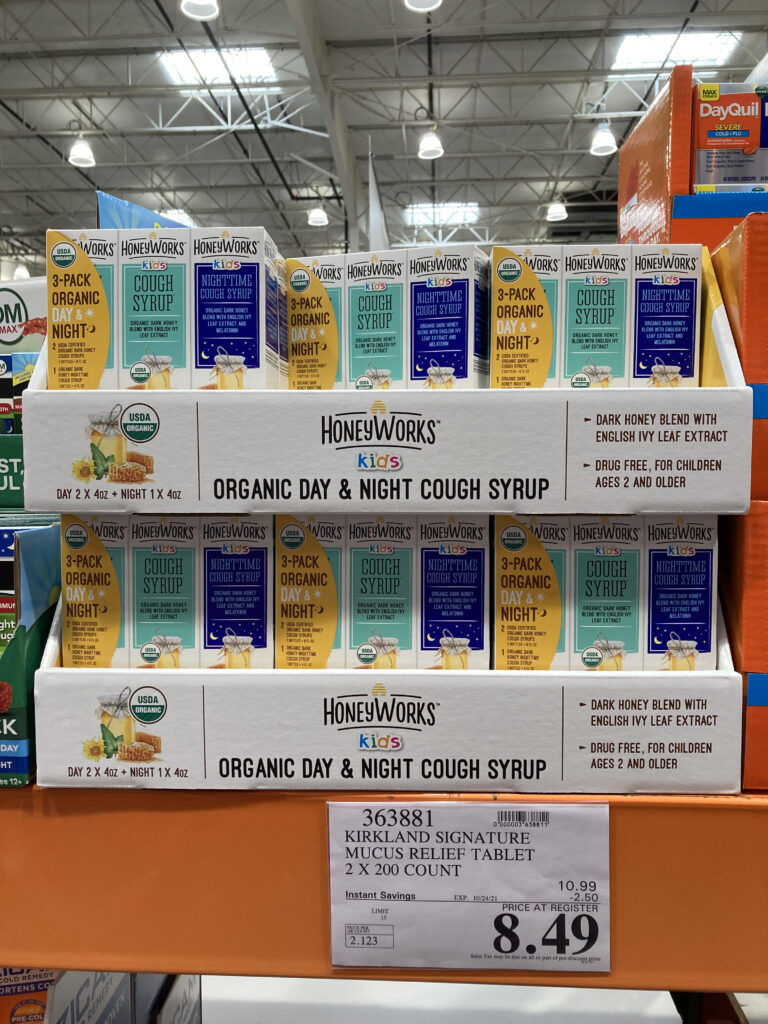
This cough syrup is honey-based and it is effective in soothing coughs, so HoneyWorksTM was a great name!
If you are stuck with the name generation phase, consider buying my DIY Naming book, because it has 32 different ways to generate additional keywords and methods to convert keywords into names.
Step 5: Sorting and Screening
At this point you should have 100+ name candidates. Quantity will drive quality, as the number of good names you generate increases as you generate more names. When companies hire NameFlashSM for a naming project, we often generate thousands of names! But realistically you cannot run trademark checks on thousands of names (unless you are a bored trademark attorney). So you have to reduce your list of names to a more reasonable number to proceed to trademark clearance. Cut your list down to 15–20 names.
One obvious way to do that is to check the names against your naming objectives and strategic positioning. Toss out names that do not meet the criteria you’ve established.
I like to organize a large list of names by creating an affinity diagram. This enables you to group similar names together into clusters. This will enable you to review the clusters and pick the strongest names in each cluster for further analysis.
Step 6: Trademark Clearance
The greatest mistake you could make would be to choose a name that conflicts with another trademark that is in use, because that trademark owner will send you a “cease and desist” letter that either results in an expensive lawsuit or an abandonment of the name by you. Either one is extremely expensive and time consuming.
A business needs to conduct a trademark search before investing time and money into a new brand. Although no search can reveal every possible conflict that may exist with a trademark, a proper search can steer you clear of any big problems. You can do your own trademark search using the United States Patent and Trademark Office. The TESS trademark search process is not the easiest process to use, but if you follow the instructions on the website you should be able to figure it out.
You can also use trademark search software such as Trademark Bob to help expedite the search process. Trademark Bob’s price is $9.99 per goods/service description, so it is reasonably affordable.
If you want to get a lawyer involved, you’ll pay more. Some trademark attorneys will do a knockout search for you for $50 to $100 per name. But a comprehensive trademark search using a trademark attorney will be a lot more.
My advice on trademark conflicts is to eliminate the obvious conflicts with a 3-step process:
- Conduct a search using the TESS search vehicle at the USPTO or Trademark Bob.
- Do a Google search for your name.
- Try to buy the www.yourname.com domain at GoDaddy.
If these 3 steps do not show any conflicts, then the odds of a serious trademark conflict are minimal.
Step 7: Validate Your Choice
At this point you should have a short list (3–5 names) of leading candidates.
Before you choose a name, you need to validate the name. And by “validate” I do not mean to ask your partner or friends what they think. In fact, any person you are friends with or are related to do not get a vote. Why? Because these people will have a built in “positive bias” to anything you suggest and will not provide honest and objective feedback. If your name is bad, they won’t tell you so because they don’t want to hurt your feelings.
The best way to validate your name is to ask your target audience what they think. Big companies would commission a several thousand-dollar market research study to accomplish this task. You can do this for a fraction of the cost by using a cost-effective research tool like 1Q (https://site.1q.com/). Simply ask the following question using your final name selections, and you can get results for as little as $1 per question per respondent:
We’ve created a new toilet bowl plunger that does a better job of clearing the blockage. What should we call it?
FastFlush
Magic Plunger
Perfect Plunge
MegaPlunger
Plungeriffic
You can spend $100 and get a good understanding of which names rise to the top from 100 members of your target audience.
Step 8: Final Assessment of Name
This one is easy! Simply use the Name Evaluation Tool to score the name you have chosen.
Hopefully you’ve developed a winning name! If you need further assistance, feel free to reach me at www.NameFlash.com!
Is The Economy Making Marketers Risk Averse?
A few years ago, Heinz embarked on a journey to extend their Heinz condiment franchise. The concept was simple and straightforward: Let’s add some stuff to ketchup/mustard/mayo and see what happens!
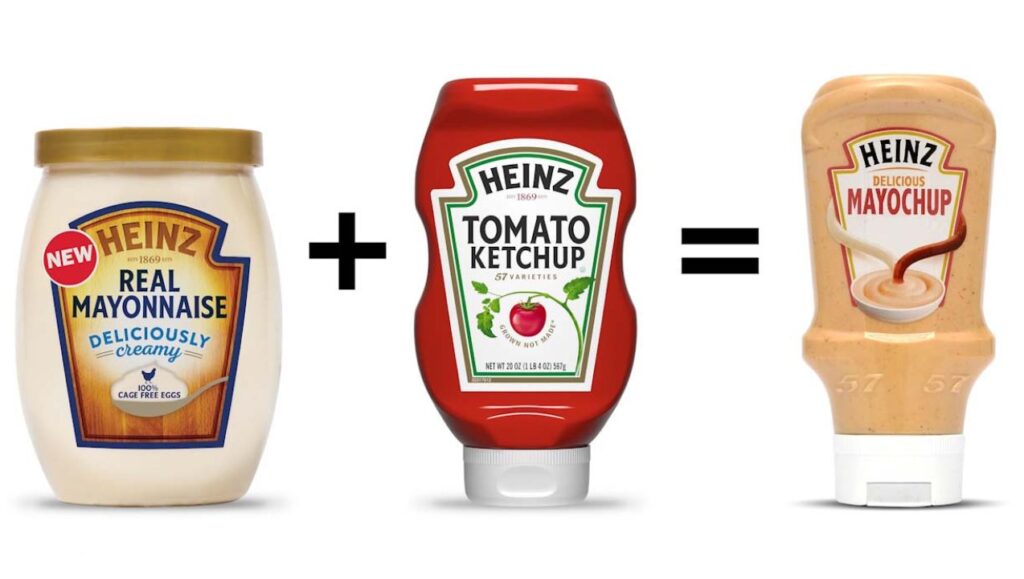
The branding was straightforward too. It was a very simple 1 + 1 = 3 idea of branding, as evidenced by the photos above and below. Add two standards together and you get a new creation! What fun!
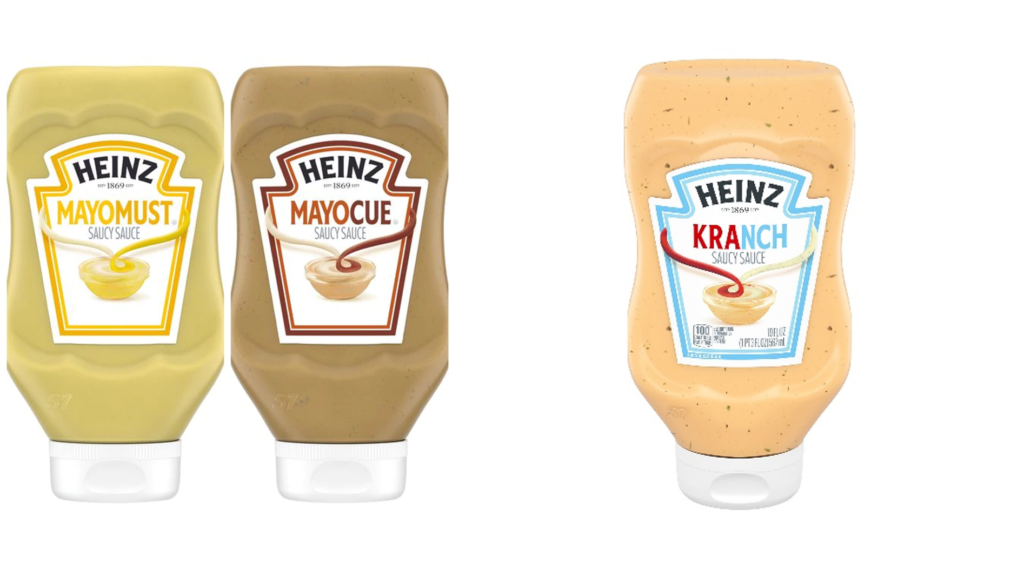
Heinz recently announced some new varieties of ketchup/sauce. They look like great products and I can’t wait to try them, but notice the simple and straightforward branding:
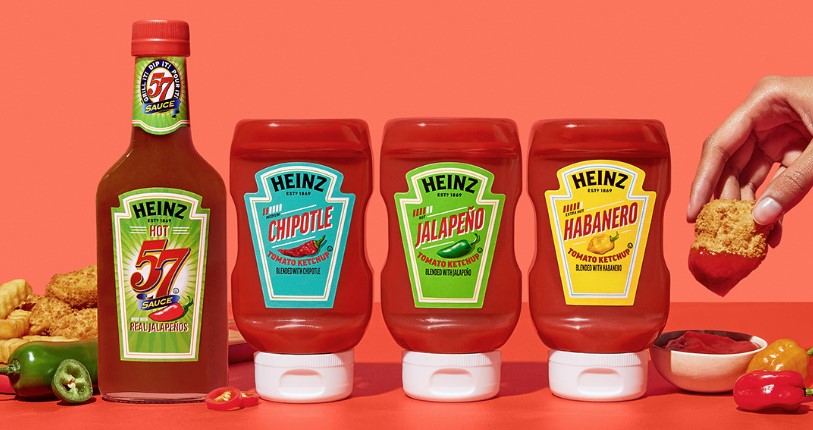
Gone are the clever monikers (e.g., MAYOCHUP) as the branding just says this is ketchup with an added ingredient.
Did Heinz not want to take the risk of introducing a new name into the category? Are consumers tired of “cute” in branding?
Time will tell if this is a blip or a trend.
My Favorite April Fools’ Event
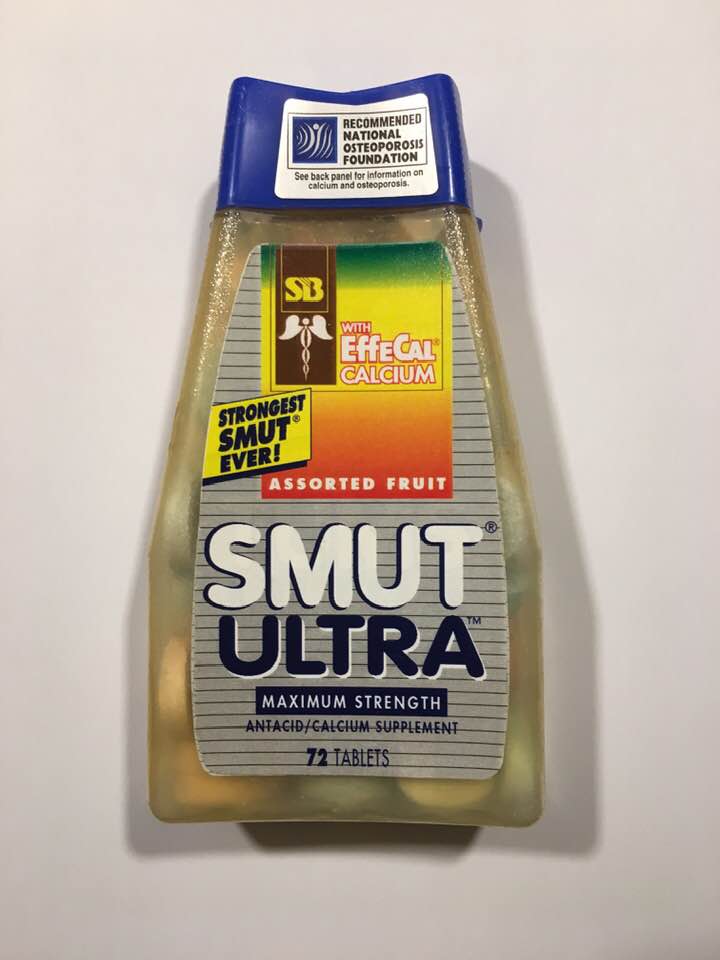
More than a few years ago, a clever marketing executive planned and executed the best April Fools’ event I’ve ever seen. He took the front label of TUMS, one of the best known brand names in America, and turned it into this unique talk piece!
How he managed to do this in an organization that is known for tight control and high standards will remain a mystery. But by flipping the TUMS logo he caused a ruckus in headquarters. He sold it well by claiming that consumers were calling in and complaining about this labeling mistake they found at retail. And this caused the plant and packaging approval teams to jump into action to figure out how this happened, and the sales teams to try to identify how widespread this packaging error was in the marketplace.
Of course, it was an April Fools’ joke and the product was not on retail shelves. But more than a few people bought into it and had quite the scare!
Well played Paul Wardle!
How To Communicate With Anyone
Just Understand How People Process Information

If you’ve ever wondered why you understand things that other people do not, you might have a different learning style than other people. Or maybe you are frustrated because you cannot get other people to understand your point of view. Again, different learning styles might be the cause.
In the field of education, it is widely recognized that students have various learning styles. One of the most widely used summaries of learning styles is Neil Fleming’s VARK model (https://vark-learn.com/) which categorized people into 4 classifications:
1. Visual Learners — People who have a preference for learning from pictures or visual aids
2. Aural Learners — These people learn through listening
3. Reading-Writing Preference Learners — Those who learn through reading & writing
4. Kinesthetic Learners — People who learn through moving or active exploration
If you are trying to do a better job of communicating with someone, you can get them to do the VARK questionnaire on that website to evaluate which communication style is their preference. Once you figure it out, then you will know how to effectively communicate with him/her!
The International Journal of Linguistics and Communication (Vol. 5(1), June 2017) has a fantastic summary of the ways to appeal to each type of learner. Check this out!
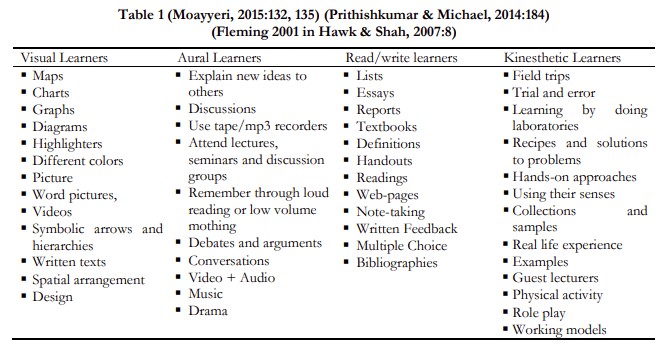
When looking at learning styles, what is fascinating to me is there are few people who are 100% of any of these modalities (data from VARK website). Fewer than 2% of people are exclusively Visual Learners. Only 4.2% of people are exclusively Read/Write. Only 5.1% are exclusively Aural Learners. The biggest block of exclusive learners is Kinesthetic at 22.8%.
And yet, how many of us try to communicate with someone in a single way (usually by writing only or by talking only)?
Combining modalities enhances learning and gets your message across to more diverse people. Therefore, communication approaches that combine modalities (such as the visual and the auditory) can be beneficial to recall and persuasion of your messaging. In fact, the largest group of learning preferences is the VARK grouping shown in brown below, which combines all 4 classifications of learning.
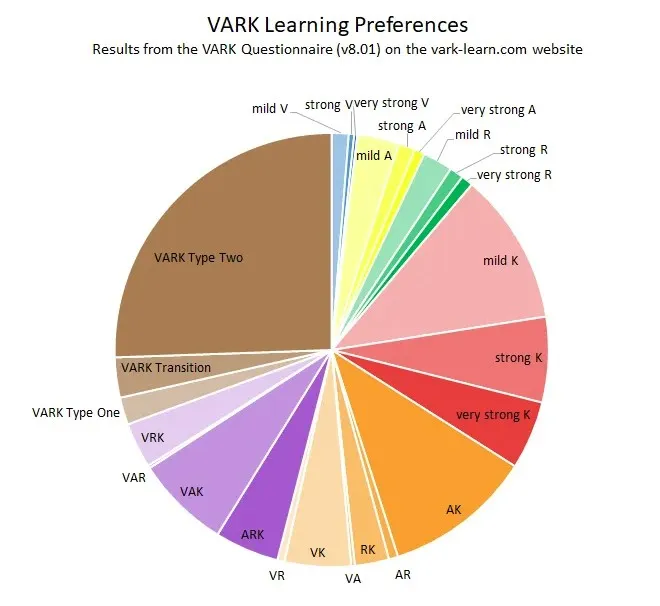
The moral of the story is simple. To enhance your communication, engage as many human senses as possible in it.
Here is a practical example from television advertising: “Snap, Crackle, Pop — Rice Krispies!” If you are of a certain age, you not only heard the jingle that went along with that phrase, but you also heard the cereal itself (which really does pop when milk is poured on it). “Plop, plop, fizz, fizz, oh what a relief it is” is another good example, as that jingle for Alka-Seltzer built a million-dollar business (and, yes, the product performs as advertised). Both examples used visual, aural, and read/write modalities to get the message across.
If you want the “quick course” on engaging the senses, you should buy this amazing book: “A Natural History of the Senses” by Diane Ackerman. She touches upon all of the senses and explores the depth and breadth that can be reached in each one. I can assure you, you won’t think of the five senses in the same way after reading this book.
Obviously multisensory communication is not possible in every situation. But if you want to communicate in a way that maximizes the number of people who understand your message, you should use as many senses as possible:
· Work hard to insert quality visuals into your articles.
· Provide a podcast for aural learners.
· And make sure you have a hands-on guide that gets people working right on the spot.
Your communication will benefit from this effort!
3 Really Is the Magic Number
If you can’t make your point in 3 then start over

Schoolhouse Rock fans already knew this, but it took a January 2014 publication in the Journal of Marketing for marketers to get confirmation.
The publication was titled: “When Three Charms but Four Alarms: Identifying the Optimal Number of Claims in Persuasion Settings.” The authors Suzanne B. Shu & Kurt A. Carlson conducted a study where consumers were shown messaging that consisted of one, two, three, four, five and six positive claims about a product such as shampoo or a breakfast cereal or even a politician. For example, in the case of the “six claim” breakfast cereal situation, participants were told:
Imagine that you are shopping at the grocery store and you notice that a brand of cereal you sometimes buy has a new package design. As you look closer you discover that they have also changed the product itself. The packaging says that it is now:
“Healthier, better tasting, crunchier, sweeter, organic, and with higher quality ingredients.”
After the participants saw the messaging, the researchers measured the attitude of each respondent to gather positive or negative impressions. They also measured the amount of skepticism the respondent had about whether the messaging was intended to inform them or to push them to choose a particular product.
The results clearly demonstrated that those who read three claims rated all of the subjects of the ads (e.g., breakfast cereal or politician) significantly more positively than respondents who had read the ads with one, two, four, five or six positive claims. The results seemed to indicate that adding additional positive claims increased appeal until the third claim, but after the third positive claim, additional claims increased skepticism which in turn lowered the overall level of persuasion.
The key is to avoid the “piling on” effect. You know how this goes…one superlative is good so two must be better so three is even better and four must be even better. There is a limit to the patience of your target market and that limit seems to top out at 3.
I’ve been tracking this trend for two decades. I credit Procter & Gamble® for starting the trend of “piling on” the benefits when they launched the Olay® Total Effects line in 2001 and introduced us to “Anti-aging skin care products that moisturize and fight seven signs of aging.” In case you don’t know, the “seven signs of aging” are “look of fine lines and wrinkles, rough texture, uneven skin tone, surface dullness, appearance of prominent pores, noticeability of age spots, and dryness.”
And wouldn’t you know it, Olay Total Effects works on all seven signs of aging (imagine that). The skeptic in me thought that maybe there were more signs of aging that Olay was not designed to work on, but I let it go and credited P&G with some good marketing insight.
The skeptic came back when I noticed Iams® advertising that provided “Seven Signs of Healthy Vitality.” Iams is another Procter & Gamble product.
And guess what…Head & Shoulders® (another P&G product) has “Seven Benefits” …fights dryness, calms itching, relieves irritation, reduces redness, controls oiliness, removes flakes, and beautiful hair.
In the next decade (2010’s), companies seemed to shift down from 7 to 5. Procter & Gamble’s Gillette® Fusion ProGlide Irritation Defense Shave Gel helps defend against the 5 signs of shaving irritation (nicks & cuts, burning, stinging, redness and tightness). Degree® deodorant offers “5 in 1” protection. Garnier® BB Cream claims to offer 5 instant results (evens tone, hydrates, renews, protects and brightens).
The cutdown from 7 to 5 reflected the ability (or lack thereof) of people to store things in their short-term memory. The classic study from 1956 by George Miller demonstrated that the maximum number of items the average person could retain in their short-term memory was seven. This supposedly was the basis for telephone numbers being seven digits long. An updated study in 2001 by Cowan (“The Magical Number 4 in Short-Term Memory: A Reconsideration of Mental Storage Capacity.” Behavioral and Brain Science 24 (2001): 87–185) found that the magic rule of seven was not true anymore and that the updated maximum is four. I would venture that if they ran the study today, 3 would be the magic number.
There could be a lot of different reasons for this including the aging of the US population (perhaps becoming more forgetful) or the fact that a more cluttered media environment makes it harder for people to retain information in short-term memory. But the key is to realize that the ability of people to retain information in short-term memory appears to be dropping.
Here is a brand that seems to be getting it right these days (ad in Costco magazine):
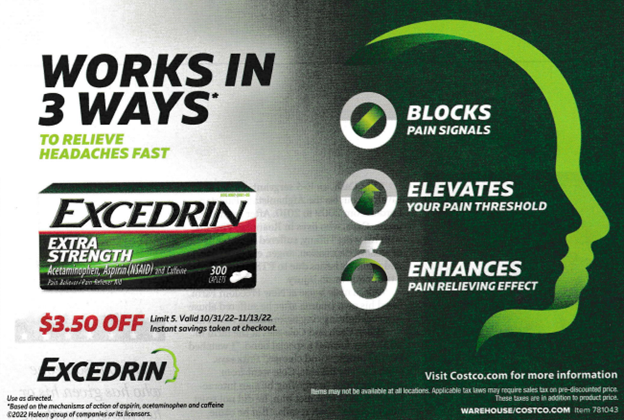
Face it. 3 is THE magic number. Shakespeare knew it (“Friends, Romans, Countrymen”). Our Founding Fathers knew it (“life, liberty, and the pursuit of happiness”). Abraham Lincoln knew it (“Government of the people, by the people, for the people”). And now you know it too!
Curiosity Killed the Cat
But It Really Revs Your Brain!

Photo by Cleyton Ewerton on Unsplash
Almost everyone loves a good magician. The magician’s sleight of hand technique in making a coin or playing card disappear/reappear delights us, as we usually take pleasure in being fooled in this manner. Once fooled, our curious brain rapidly kicks into gear and tries to figure out how the magician did the trick. Sometimes you figure it out, and then you get even greater pleasure. Even when you can’t figure it out, you are still amazed!
Magic tricks only work if two things occur. First, the magician must divert your attention away from where the actual trick is happening, and second, your brain must fill in any missing information by combining what you already know with whatever you perceive at that very moment. Truth be told, the magician is not creating the illusion — your brain is creating the illusion that something has happened (when in reality the magician has done something else).
The science behind the brain’s “filling in” process is fascinating (read this Discover magazine article). The sub-headline of the article says it all: “The eye and brain work in a partnership to interpret conflicting signals from the outside world. Ultimately, we see whatever our brains think we should.”
Here is a great example of how the “filling in” process works. Quickly read the paragraph below:
It deosn’t mttaer in waht oredr all the ltteers in a wrod are. You can stlil raed it wouthit a porbelm bcuseae the huamn mnid wroks by a porecss of ptatern rceigontion. It dtemrines maennig bfoere porecssnig dteails.
Isn’t tihs amzanig? Your brain can make sense of even the most chaotic situation.
Another way the brain “fills in” to provide a seamless reality is dealing with blind spots. I’m not talking about the areas where you cannot see in the rear-view mirror of your car! I’m talking about the significant gaps that exist in your vision. You may not be aware of them, but there are parts of your retina that have no photoreceptors and therefore you are essentially blind in that area. Nevertheless, your brain fills in those gaps so your perception of reality is flawless.
The “filling in” process has been shown in numerous studies to be important to generating lasting recall and favorable persuasion of messages and experiences. If the person’s brain is engaged and filling in the gaps, then the person will remember the experience and usually be favorable towards it.
By engaging with a mind puzzle, your brain is demonstrating curiosity. Author Ian Leslie describes curiosity as a combination of intelligence, persistence, and hunger for novelty in his book Curious: The Desire To Know And Why Your Future Depends On It. He makes a strong argument that maintaining curiosity is critically important as we grow older and are subjected to ever-increasing demands on our focus.
In their Psychology Today article The Mind of the Puzzler psychologists Sternberg and Davidson argued that solving puzzles entails the ability to compare hidden information in a puzzle with information already in memory. More importantly, in order to solve a puzzle, the brain must combine the two types of information to form novel ideas. When the brain successfully identifies the pattern or twist that the puzzle entails, you will typically get an “Aha! Effect” which leads to a positive emotional feeling as well. Challenging your brain with puzzles has been shown to improve memory and brain function in numerous clinical studies (here is the latest).
Another great way to engage your curious brain is to read mysteries. Mysteries are often more engaging than puzzles because often there is no definitive answer as there is with a crossword puzzle. Mysteries are murkier, and the brain likes to be challenged with questions that are complex and interrelated.
Curiosity has been shown to be a great benefit to the human brain. We should all strive to be more curious about our lives, especially as we get older. So read a great mystery or do a daily crossword puzzle! Engage with a different group of people. Learn some new skills. Your brain will thank you later!
Simpler Is Better
Why is everything so complicated these days?
Case in point. Starbucks Drink Sizes:
Short (8 Oz.)
Tall (12 Oz.)
Grande (16 Oz.)
Venti (Hot — 20 Oz., Cold — 24 Oz.)
Trenta (30 Oz.)
Brooklyn Fare had some fun with this in their coffee cup redesign, but there is a real point to be made here. Why do we complicate things?

Why can’t the coffee sizes at Starbucks be:
Short becomes Mini
Tall becomes Small
Grande becomes Medium
Venti becomes Large
Trenta becomes Extra Large
Want more evidence of how companies are complicating things? Here are the sizes of ice cream at Cold Stone Creamery:
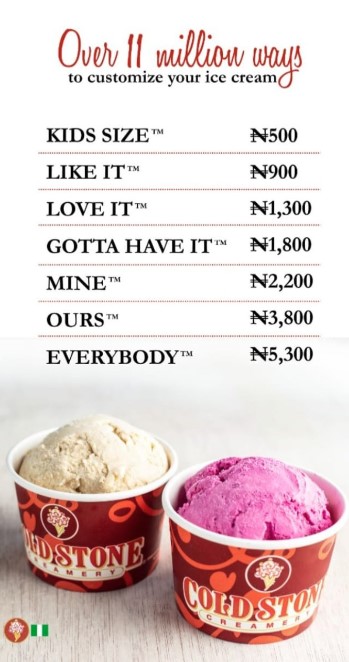
Imagine trying to order the proper size without referring to this menu. What ever happened to small, medium and large?
Science is solidly in the camp of simplicity. Adam Alter and Daniel Oppenheimer hypothesized that people would have an affinity for simple names that are easier to pronounce. They used names of fictitious stocks that were either hard to pronounce (i.e., Sagxter, Xagibdan) or easy to pronounce (i.e., Slingerman, Vander). They told respondents that these were real companies and asked them to estimate the future performance of the company. People indicated that the easily pronounced stocks would increase in value and the more complicated sounding stocks would decrease in value. Furthermore, the researchers then examined actual stock performance for 89 randomly picked stocks that had an initial public offering between 1990 and 2004. The stock performance for the first year of easily pronounced stocks was significantly higher than that of stocks with more difficult names. Simpler is better.
A study at the University of Michigan looked at fluency, familiarity and risk perception in names. In one study, the researchers asked participants to rate the potential harm of food additives with easy and difficult to pronounce names. Consumers consistently rated names that were difficult to pronounce as being more risky than those additives with names that were easy to pronounce. Simpler is better.
In another study, the University of Michigan researchers asked people to assess whether amusement park rides would be adventurous and exciting, or too risky and likely to make them sick, solely based on the name. Consistent with the food additive study, participants rated rides with difficult names unfavorably. The researchers concluded that “people perceive disfluently processed stimuli as riskier than fluently processed stimuli.” In other words, simpler is better.
A local food court has a chicken restaurant that has rebranded. They used to be known as “chickenow” which is a linguistically difficult and complex name.
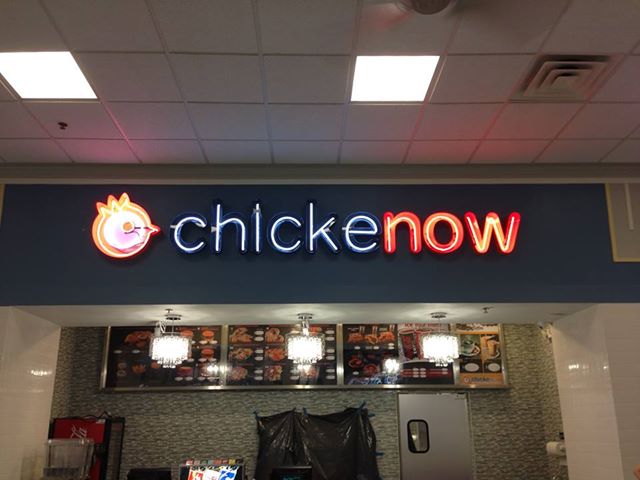
Recently they rebranded to “Chicken & Fries.”
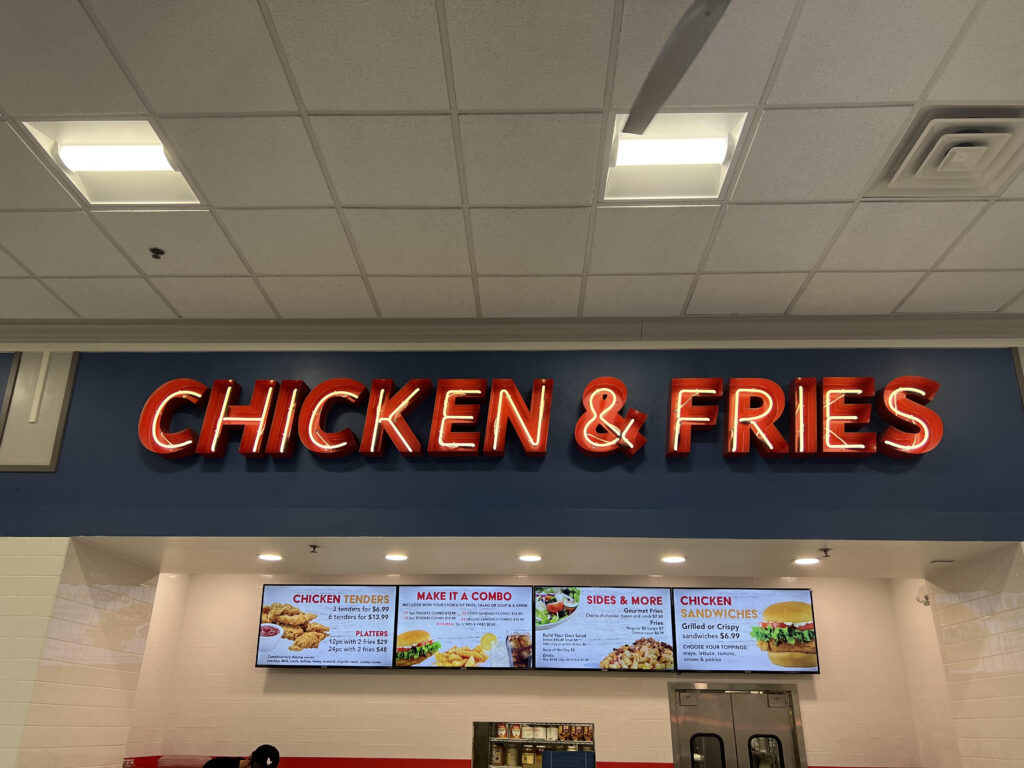
If you want to get picky you could argue that “Chicken & Fries” has gone too far into the generic camp. But you won’t ever be confused about what you can buy there.
Simpler is better. C’mon people, let’s simplify!
We Count Only Blue Cars
To Be More Memorable, Be Familiar (But Different)
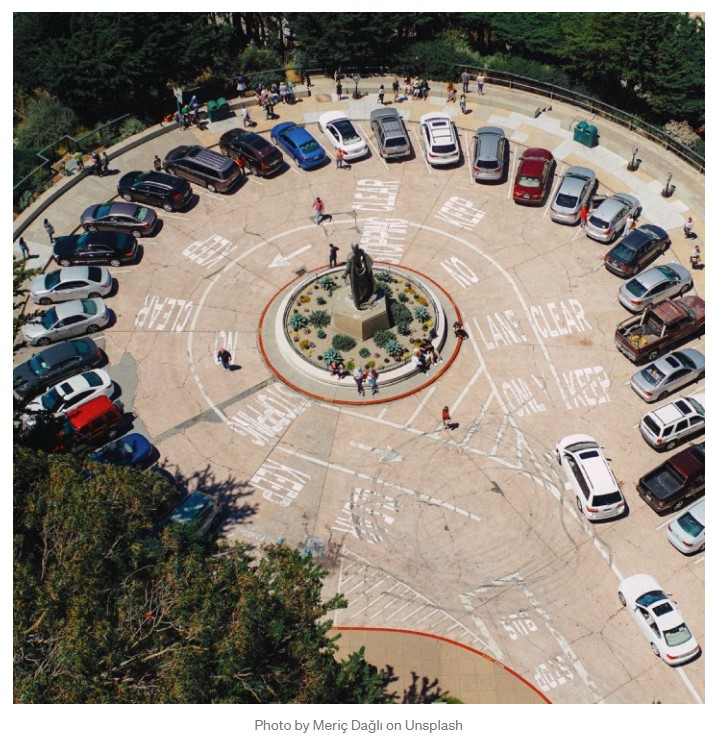
There is a simple technique that can make you or your actions more memorable. The key is to be familiar (but different).
Want to have your creative efforts stand out? People who are creative are perceived as being different, but you don’t want to be too different because being too different is borderline weird and few people want to be around weird.
Want to advance up the Corporate Ladder? Usually people who fit in (are familiar) will advance faster but you don’t want to be too familiar because you will blend into the sameness around you.
The sweet spot is the intersection of familiar and different. Or more correctly, you need to start with the familiar and add some differentiation. Familiar (but different) is a comfortable way to be more memorable because the human brain is comfortable with the familiar but detects the differences and works hard to make sense of them, thereby making the experience a memorable one.
Here is a visual way to demonstrate the issue. In the three groups of circles shown below, the circle in the center is always the same size. However, as you can see, the center circle looks smaller or larger based upon the size of the other circles surrounding it. The group of circles on the right has six similarly sized circles, and you can see how it is impossible to distinguish one from another. If you want to stand out, it is far better to be the outlier, such as the center circle in the first two groups of circles. But being a triangle in a group of circles might be perceived as being too different.

Familiar (but different) works because our brains are wired to find differences. Perhaps this goes back to the need to be aware of the presence of threats like man-eating animals. Or maybe we just don’t overburden our brains with information about things that are familiar, but when differences appear we start to pay attention.
In his landmark book, Thinking, Fast and Slow, Daniel Kahneman discusses the differences between two types of thinking: System 1 and System 2. System 1 thinking is based in our intuitive system and is quick, automatic, effortless and emotional. This is the type of thinking that causes people to make “snap” judgments and fail to observe subtle differences. System 2 thinking is slower and more conscious, logical and “deeper.” System 2 thinking creates more memorable events.
Here is an example from the world of branding. In the Philippines there is a very famous burger joint called “Regrub.” The food is great and is no doubt a major reason for their success. But a good part of their awareness comes from the fact that their name has a lot of people thinking, “Why did they name it Regrub?” After they ponder for a while, they then realize that it is the word “Burger” spelled backwards. They then go on to tell their friends about the new place with the unique name which helps to build the success story.
There are many examples in the art world. Andy Warhol created high impact paintings of familiar images such as Campbell’s Soup Cans or Brillo boxes. Even his famous portraits of Marilyn Monroe and Elvis Presley were made from common close-up photos of celebrities. Andy became famous by making the familiar different.
“We count only blue cars” is a lyric from the hit song “Counting Blue Cars” by Dishwalla. This lyric is actually a wonderful observation of human nature. If you only saw white cars all day long, then blue cars would be something special and you would pay attention to them. Life is like that often where the sameness seems to pass by without being noticed. To be memorable, you need to be familiar (car) but different (blue). In that way you’ll be noticed and remembered!
Liquid Death – Good Branding or Good Marketing?
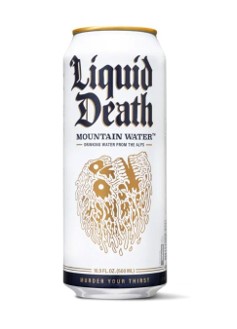
Let’s get this out of the way. Liquid Death is just water sold in beer cans. OK, now they are moving into flavors and fizzy water, but the brand was built on “mountain water in a beer can.”
So how do you explain their success (they recently closed another round of fundraising bringing its valuation to $700 million)? Is it the Branding or the Marketing behind the Branding?
Its latest investor, Peter Pham, seems to credit the name as he wrote in a Medium post that “Like Tesla moved drivers toward better-for-the-planet EVs through a great product and brand that became part of culture,” Pham wrote, “Liquid Death is moving people toward healthier and sustainable drinking options, not by preaching to them, but by entertaining them and making them a part of something bigger in culture.”
Others have credited the unique packaging and subversive marketing which has used bizarre ads (e.g., Martha Stewart Severed Hand https://liquiddeath.com/pages/martha) and Twitter influencers to define the brand as fast growing and a true disruptor in the non-alcoholic beverage market.
The way I make the call is to look at one without the other. If Liquid Death was on the shelf without the marketing would it work? Probably not. If the marketing was used to sell another brand of water in a beer can would it work? Probably, depending upon the name. So my conclusion would be the marketing is the hero, and the brand was the platform that enabled the success. Together they obviously are a great success. But in my opinion, the Liquid Death name is not the lynchpin as any of a number of names would have worked just as well with that fantastic marketing.

